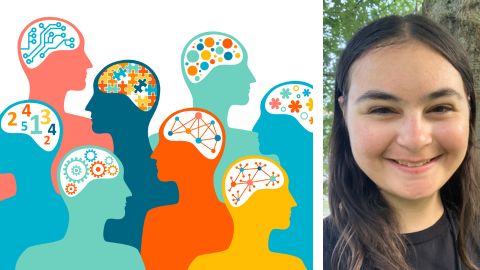Lessons from plants: A changing environment
The following is an excerpt from Beronda Montgomery's new book, "Lessons From Plants," published by Harvard University Press.

I vividly remember one of the first science experiments I ever performed, when I was in kindergarten. By watching a simple bean seedling grow, I learned about the remarkable ability of plants to adapt to their environment — and now, decades later, I am still in awe at that ability. The experiment was coordinated by my kindergarten teacher, who instructed each of us to grow a bean seedling on a windowsill at home. We were to put wet cotton balls or some wet soil in the bottom of a plastic cup, add a few beans, and observe them daily. One day when I looked at my beans, I made an exciting discovery. I noticed that a crack had appeared in one of them, and a tiny root was emerging from the crack. Then, in the days that followed, a stem began to emerge from the other end of the bean, and tiny leaves unfurled. Reaching toward the sun in our window, the bean plant continued to grow.
A few weeks later, the teacher asked all of us to bring in our seedlings for show and tell. The plants, I was surprised to see, were not all the same: Some were short and stocky, while others were tall and spindly. The teacher explained that these differences depended on how much light we'd each had coming through our window. If the windowsill was shady, the plant would grow tall to try to reach the light. This was my first exposure to an essential feature of plants — that they are exquisitely attuned not just to light levels, but to a whole array of environmental conditions.
Plants are aware of light, water availability and moisture level, and nutrient abundance in the soil. They perceive changes in these factors as they scan the environment and assess what responses they need to make. Based on the information they gather, they are able to alter their behavior, morphology, and physiology in response to changes in their surroundings.
Most of us know that bean seedlings, like other green plants, use light to make food through the process of photosynthesis. But few of us know the fascinating details of how they respond to shifting light conditions. Light influences plants from the very beginning of their life cycle; while still underground, some seeds are stimulated by light to germinate. While the root follows gravity to grow downward, the shoot grows upward toward the light. The first leaves to appear are the embryonic leaves, or cotyledons. They accumulate molecules of the pigment chlorophyll, which "captures" light energy. The bean seedling's leaves appear green to the human eye because chlorophyll absorbs red and blue light, leaving the green portion of the visible spectrum to pass through or be reflected. The photoreceptors in our eyes see the wavelengths that are not used by light-gathering photosynthetic pigments.
As the seedling continues to grow and mature, its leaves stretch toward the sun to gather photons — quanta of electromagnetic energy. Chlorophyll molecules in the leaves convert light energy to chemical energy. That energy is then used to turn carbon dioxide into carbohydrates. It is through this process of photosynthesis — the harvesting of sunlight to drive conversion of inorganic carbon, in the form of carbon dioxide, to fixed carbon, in the form of sugars — that plants make their food.
The bean's new leaves are not just passive recipients of light. They make adjustments depending on how much light they receive. But how do they measure the light? Scientists have discovered that plants are able to detect the number of photons absorbed by a unit of leaf surface area per unit of time. The rate of photons hitting the surface of a leaf affects many plant processes because it controls the rate of photosynthetic reactions; more photons means more excited electrons, which means faster reactions.
The chlorophyll molecules that are central to this calculation of photon density are contained in complex light-gathering systems, called "antennae," that trap and transport light energy to "reaction centers," where the chemical reactions take place. The efficiency with which plants collect, convert, and harness energy can easily rival any solar cell. But the bean plant in your garden can do something no solar cell can currently do — it can modify its light-gathering structures in response to dynamic external cues such as dim versus bright light, or a change in the predominance of different colors of light.
Experiments that my laboratory and others have conducted with plants and cyanobacteria — bacteria that carry out photosynthesis — reveal a remarkable ability to adjust the light-gathering system to adapt to different light conditions. If light is too dim, levels of photosynthesis can be too low to provide the organism's energy needs. But too much light exposure is also detrimental. When available light exceeds the capacity for light absorption, the excess energy can generate toxic byproducts. What a plant wants to do is to maximize light absorption while limiting damage. It does this by "tuning" its light-harvesting system to external light conditions.
Plants and photosynthetic bacteria tune their antennae in several ways. They are able to match the specific light-harvesting proteins contained in the antennae to the wavelengths of light available. They can also adjust the size of their light-harvesting complexes; these complexes become larger in low light conditions, to increase light absorption, and smaller in bright conditions, to limit potential damage. It is an intricate balance to obtain just enough but not too much light energy. Through these complex modifications of their light-gathering system, plants maximize their energy production to support essential activities.
At the same time that a newly sprouted seedling is making these adjustments within the cells, it is also adjusting its stem and leaves in an effort to maximize light absorption. The difference in height of the bean seedlings that my fellow kindergartners and I had brought to class was the result of coordinated communication between the seedlings' tissues and organs based on available light. Stem position is vitally important, since it determines the location of the leaves, and it is the leaves that absorb the light required for producing chemical energy and sugars. When the leaves sense that they are in a favorable position for receiving adequate light, they send a chemical "stop" signal to the stem, which inhibits further elongation. This process, known as de-etiolation, results in plants with short stems and well- developed leaves. If the leaves are not able to harvest enough energy because of poor light conditions, however, they send a "go" signal to the stem to elongate, with the goal of getting the leaves into better light. This process, etiolation, results in seedlings with long stems and few leaves.
Enjoy reading ASBMB Today?
Become a member to receive the print edition four times a year and the digital edition monthly.
Learn moreGet the latest from ASBMB Today
Enter your email address, and we’ll send you a weekly email with recent articles, interviews and more.
Latest in Opinions
Opinions highlights or most popular articles

Sketching, scribbling and scicomm
Graduate student Ari Paiz describes how her love of science and art blend to make her an effective science communicator.

Embrace your neurodivergence and flourish in college
This guide offers practical advice on setting yourself up for success — learn how to leverage campus resources, work with professors and embrace your strengths.

Survival tools for a neurodivergent brain in academia
Working in academia is hard, and being neurodivergent makes it harder. Here are a few tools that may help, from a Ph.D. student with ADHD.

Hidden strengths of an autistic scientist
Navigating the world of scientific research as an autistic scientist comes with unique challenges —microaggressions, communication hurdles and the constant pressure to conform to social norms, postbaccalaureate student Taylor Stolberg writes.

Black excellence in biotech: Shaping the future of an industry
This Black History Month, we highlight the impact of DEI initiatives, trailblazing scientists and industry leaders working to create a more inclusive and scientific community. Discover how you can be part of the movement.

Attend ASBMB’s career and education fair
Attending the ASBMB career and education fair is a great way to explore new opportunities, make valuable connections and gain insights into potential career paths.

